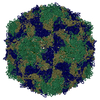+ Open data
Open data
- Basic information
Basic information
| Entry | Database: PDB / ID: 7vy5 | ||||||
|---|---|---|---|---|---|---|---|
| Title | Coxsackievirus B3 (VP3-234Q) incubation with CD55 at pH7.4 | ||||||
 Components Components |
| ||||||
 Keywords Keywords | VIRUS / CVB3 / VP3-234Q / CD55 | ||||||
| Function / homology |  Function and homology information Function and homology informationsymbiont-mediated perturbation of host transcription / regulation of lipopolysaccharide-mediated signaling pathway / negative regulation of complement activation / regulation of complement-dependent cytotoxicity / regulation of complement activation / respiratory burst / positive regulation of CD4-positive, alpha-beta T cell activation / positive regulation of CD4-positive, alpha-beta T cell proliferation / Class B/2 (Secretin family receptors) / symbiont-mediated suppression of host cytoplasmic pattern recognition receptor signaling pathway via inhibition of RIG-I activity ...symbiont-mediated perturbation of host transcription / regulation of lipopolysaccharide-mediated signaling pathway / negative regulation of complement activation / regulation of complement-dependent cytotoxicity / regulation of complement activation / respiratory burst / positive regulation of CD4-positive, alpha-beta T cell activation / positive regulation of CD4-positive, alpha-beta T cell proliferation / Class B/2 (Secretin family receptors) / symbiont-mediated suppression of host cytoplasmic pattern recognition receptor signaling pathway via inhibition of RIG-I activity / ficolin-1-rich granule membrane / complement activation, classical pathway / transport vesicle / side of membrane / COPI-mediated anterograde transport / symbiont-mediated suppression of host cytoplasmic pattern recognition receptor signaling pathway via inhibition of MDA-5 activity / endoplasmic reticulum-Golgi intermediate compartment membrane / symbiont-mediated suppression of host cytoplasmic pattern recognition receptor signaling pathway via inhibition of MAVS activity / secretory granule membrane / Regulation of Complement cascade / picornain 2A / symbiont-mediated suppression of host mRNA export from nucleus / symbiont genome entry into host cell via pore formation in plasma membrane / picornain 3C / T=pseudo3 icosahedral viral capsid / positive regulation of T cell cytokine production / host cell cytoplasmic vesicle membrane / nucleoside-triphosphate phosphatase / channel activity / positive regulation of cytosolic calcium ion concentration / virus receptor activity / monoatomic ion transmembrane transport / symbiont-mediated suppression of host NF-kappaB cascade / DNA replication / RNA helicase activity / membrane raft / endocytosis involved in viral entry into host cell / Golgi membrane / symbiont-mediated activation of host autophagy / innate immune response / RNA-directed RNA polymerase / cysteine-type endopeptidase activity / viral RNA genome replication / RNA-directed RNA polymerase activity / DNA-templated transcription / lipid binding / Neutrophil degranulation / virion attachment to host cell / host cell nucleus / structural molecule activity / cell surface / ATP hydrolysis activity / proteolysis / RNA binding / extracellular exosome / extracellular region / zinc ion binding / ATP binding / membrane / plasma membrane Similarity search - Function | ||||||
| Biological species |   Coxsackievirus B3 Coxsackievirus B3 Homo sapiens (human) Homo sapiens (human) | ||||||
| Method | ELECTRON MICROSCOPY / single particle reconstruction / cryo EM / Resolution: 3.15 Å | ||||||
 Authors Authors | Wang, Q.L. / Liu, C.C. | ||||||
| Funding support |  China, 1items China, 1items
| ||||||
 Citation Citation |  Journal: Proc Natl Acad Sci U S A / Year: 2022 Journal: Proc Natl Acad Sci U S A / Year: 2022Title: Molecular basis of differential receptor usage for naturally occurring CD55-binding and -nonbinding coxsackievirus B3 strains. Authors: Qingling Wang / Qian Yang / Congcong Liu / Guoqing Wang / Hao Song / Guijun Shang / Ruchao Peng / Xiao Qu / Sheng Liu / Yingzi Cui / Peiyi Wang / Wenbo Xu / Xin Zhao / Jianxun Qi / Mengsu Yang / George F Gao /  Abstract: Receptor usage defines cell tropism and contributes to cell entry and infection. Coxsackievirus B (CVB) engages coxsackievirus and adenovirus receptor (CAR), and selectively utilizes the decay- ...Receptor usage defines cell tropism and contributes to cell entry and infection. Coxsackievirus B (CVB) engages coxsackievirus and adenovirus receptor (CAR), and selectively utilizes the decay-accelerating factor (DAF; CD55) to infect cells. However, the differential receptor usage mechanism for CVB remains elusive. This study identified VP3-234 residues (234Q/N/V/D/E) as critical population selection determinants during CVB3 virus evolution, contributing to diverse binding affinities to CD55. Cryoelectron microscopy (cryo-EM) structures of CD55-binding/nonbinding isolates and their complexes with CD55 or CAR were obtained under both neutral and acidic conditions, and the molecular mechanism of VP3-234 residues determining CD55 affinity/specificity for naturally occurring CVB3 strains was elucidated. Structural and biochemical studies in vitro revealed the dynamic entry process of CVB3 and the function of the uncoating receptor CAR with different pH preferences. This work provides detailed insight into the molecular mechanism of CVB infection and contributes to an in-depth understanding of enterovirus attachment receptor usage. | ||||||
| History |
|
- Structure visualization
Structure visualization
| Movie |
 Movie viewer Movie viewer |
|---|---|
| Structure viewer | Molecule:  Molmil Molmil Jmol/JSmol Jmol/JSmol |
- Downloads & links
Downloads & links
- Download
Download
| PDBx/mmCIF format |  7vy5.cif.gz 7vy5.cif.gz | 178.3 KB | Display |  PDBx/mmCIF format PDBx/mmCIF format |
|---|---|---|---|---|
| PDB format |  pdb7vy5.ent.gz pdb7vy5.ent.gz | 138.6 KB | Display |  PDB format PDB format |
| PDBx/mmJSON format |  7vy5.json.gz 7vy5.json.gz | Tree view |  PDBx/mmJSON format PDBx/mmJSON format | |
| Others |  Other downloads Other downloads |
-Validation report
| Summary document |  7vy5_validation.pdf.gz 7vy5_validation.pdf.gz | 1.1 MB | Display |  wwPDB validaton report wwPDB validaton report |
|---|---|---|---|---|
| Full document |  7vy5_full_validation.pdf.gz 7vy5_full_validation.pdf.gz | 1.1 MB | Display | |
| Data in XML |  7vy5_validation.xml.gz 7vy5_validation.xml.gz | 37.1 KB | Display | |
| Data in CIF |  7vy5_validation.cif.gz 7vy5_validation.cif.gz | 56.6 KB | Display | |
| Arichive directory |  https://data.pdbj.org/pub/pdb/validation_reports/vy/7vy5 https://data.pdbj.org/pub/pdb/validation_reports/vy/7vy5 ftp://data.pdbj.org/pub/pdb/validation_reports/vy/7vy5 ftp://data.pdbj.org/pub/pdb/validation_reports/vy/7vy5 | HTTPS FTP |
-Related structure data
| Related structure data |  32194MC  7vxhC  7vxzC  7vy0C  7vy6C  7vykC  7vylC  7vymC  7w14C  7w17C M: map data used to model this data C: citing same article ( |
|---|---|
| Similar structure data |
- Links
Links
- Assembly
Assembly
| Deposited unit | 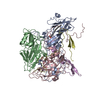
|
|---|---|
| 1 | x 60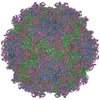
|
| 2 |
|
| 3 | x 5
|
| 4 | x 6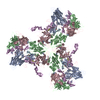
|
| 5 | 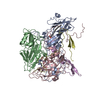
|
| Symmetry | Point symmetry: (Schoenflies symbol: I (icosahedral)) |
- Components
Components
-Capsid protein ... , 3 types, 3 molecules ABC
| #1: Protein | Mass: 30167.762 Da / Num. of mol.: 1 Source method: isolated from a genetically manipulated source Source: (gene. exp.)   Coxsackievirus B3 / Cell line (production host): Rhabdomyosarcoma CELLs / Production host: Coxsackievirus B3 / Cell line (production host): Rhabdomyosarcoma CELLs / Production host:  Homo sapiens (human) / Tissue (production host): Muscle / References: UniProt: P03313 Homo sapiens (human) / Tissue (production host): Muscle / References: UniProt: P03313 |
|---|---|
| #2: Protein | Mass: 28076.682 Da / Num. of mol.: 1 Source method: isolated from a genetically manipulated source Source: (gene. exp.)   Coxsackievirus B3 / Cell line (production host): Rhabdomyosarcoma CELLs / Production host: Coxsackievirus B3 / Cell line (production host): Rhabdomyosarcoma CELLs / Production host:  Homo sapiens (human) / Tissue (production host): Muscle / References: UniProt: P03313 Homo sapiens (human) / Tissue (production host): Muscle / References: UniProt: P03313 |
| #3: Protein | Mass: 26227.725 Da / Num. of mol.: 1 Source method: isolated from a genetically manipulated source Source: (gene. exp.)   Coxsackievirus B3 / Cell line (production host): Rhabdomyosarcoma CELLs / Production host: Coxsackievirus B3 / Cell line (production host): Rhabdomyosarcoma CELLs / Production host:  Homo sapiens (human) / Tissue (production host): Muscle / References: UniProt: P03313 Homo sapiens (human) / Tissue (production host): Muscle / References: UniProt: P03313 |
-Protein , 2 types, 2 molecules DE
| #4: Protein | Mass: 7349.039 Da / Num. of mol.: 1 Source method: isolated from a genetically manipulated source Source: (gene. exp.)   Coxsackievirus B3 / Strain: Nancy / Cell line (production host): Rhabdomyosarcoma CELLs / Production host: Coxsackievirus B3 / Strain: Nancy / Cell line (production host): Rhabdomyosarcoma CELLs / Production host:  Homo sapiens (human) / Tissue (production host): Muscle / References: UniProt: P03313 Homo sapiens (human) / Tissue (production host): Muscle / References: UniProt: P03313 |
|---|---|
| #5: Protein | Mass: 13535.401 Da / Num. of mol.: 1 Source method: isolated from a genetically manipulated source Source: (gene. exp.)  Homo sapiens (human) / Gene: CD55 / Production host: Homo sapiens (human) / Gene: CD55 / Production host:  |
-Non-polymers , 1 types, 1 molecules 
| #6: Chemical | ChemComp-PLM / |
|---|
-Details
| Has ligand of interest | N |
|---|---|
| Has protein modification | Y |
| Sequence details | AUTHORS STATE THAT THE GENEBANK ACCESSION NUMBER IS KJ025083 FOR THIS CAPSID PROTEIN. |
-Experimental details
-Experiment
| Experiment | Method: ELECTRON MICROSCOPY |
|---|---|
| EM experiment | Aggregation state: PARTICLE / 3D reconstruction method: single particle reconstruction |
- Sample preparation
Sample preparation
| Component | Name: Coxsackievirus B3 / Type: VIRUS / Entity ID: #1-#5 / Source: RECOMBINANT |
|---|---|
| Molecular weight | Experimental value: NO |
| Source (natural) | Organism:   Coxsackievirus B3 Coxsackievirus B3 |
| Source (recombinant) | Organism:  Homo sapiens (human) Homo sapiens (human) |
| Details of virus | Empty: NO / Enveloped: NO / Isolate: STRAIN / Type: VIRION |
| Natural host | Organism: Homo sapiens |
| Buffer solution | pH: 7.4 |
| Specimen | Embedding applied: NO / Shadowing applied: NO / Staining applied: NO / Vitrification applied: YES |
| Specimen support | Grid type: PELCO Ultrathin Carbon with Lacey Carbon |
| Vitrification | Instrument: FEI VITROBOT MARK IV / Cryogen name: ETHANE / Humidity: 100 % / Chamber temperature: 277 K |
- Electron microscopy imaging
Electron microscopy imaging
| Experimental equipment |  Model: Titan Krios / Image courtesy: FEI Company |
|---|---|
| Microscopy | Model: FEI TITAN KRIOS |
| Electron gun | Electron source:  FIELD EMISSION GUN / Accelerating voltage: 300 kV / Illumination mode: FLOOD BEAM FIELD EMISSION GUN / Accelerating voltage: 300 kV / Illumination mode: FLOOD BEAM |
| Electron lens | Mode: BRIGHT FIELD / Nominal magnification: 75000 X / Nominal defocus max: 2500 nm / Nominal defocus min: 1500 nm / Calibrated defocus min: 1800 nm / Calibrated defocus max: 5000 nm / Cs: 2.7 mm / C2 aperture diameter: 70 µm / Alignment procedure: COMA FREE |
| Specimen holder | Cryogen: NITROGEN / Specimen holder model: FEI TITAN KRIOS AUTOGRID HOLDER / Temperature (max): 70 K / Temperature (min): 70 K |
| Image recording | Average exposure time: 1 sec. / Electron dose: 40 e/Å2 / Detector mode: COUNTING / Film or detector model: FEI FALCON III (4k x 4k) |
| Image scans | Width: 4096 / Height: 4096 |
- Processing
Processing
| EM software |
| |||||||||||||||||||||||||||||||||||||||||||||
|---|---|---|---|---|---|---|---|---|---|---|---|---|---|---|---|---|---|---|---|---|---|---|---|---|---|---|---|---|---|---|---|---|---|---|---|---|---|---|---|---|---|---|---|---|---|---|
| CTF correction | Type: PHASE FLIPPING AND AMPLITUDE CORRECTION | |||||||||||||||||||||||||||||||||||||||||||||
| Particle selection | Num. of particles selected: 158446 | |||||||||||||||||||||||||||||||||||||||||||||
| 3D reconstruction | Resolution: 3.15 Å / Resolution method: FSC 0.143 CUT-OFF / Num. of particles: 12178 / Symmetry type: POINT | |||||||||||||||||||||||||||||||||||||||||||||
| Atomic model building | Protocol: RIGID BODY FIT / Space: REAL | |||||||||||||||||||||||||||||||||||||||||||||
| Atomic model building | 3D fitting-ID: 1 / Accession code: 1COV / Initial refinement model-ID: 1 / PDB-ID: 1COV / Source name: PDB / Type: experimental model
|
 Movie
Movie Controller
Controller












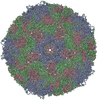

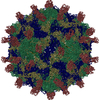

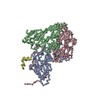
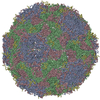
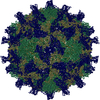
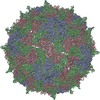
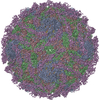
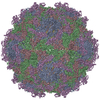
 PDBj
PDBj












